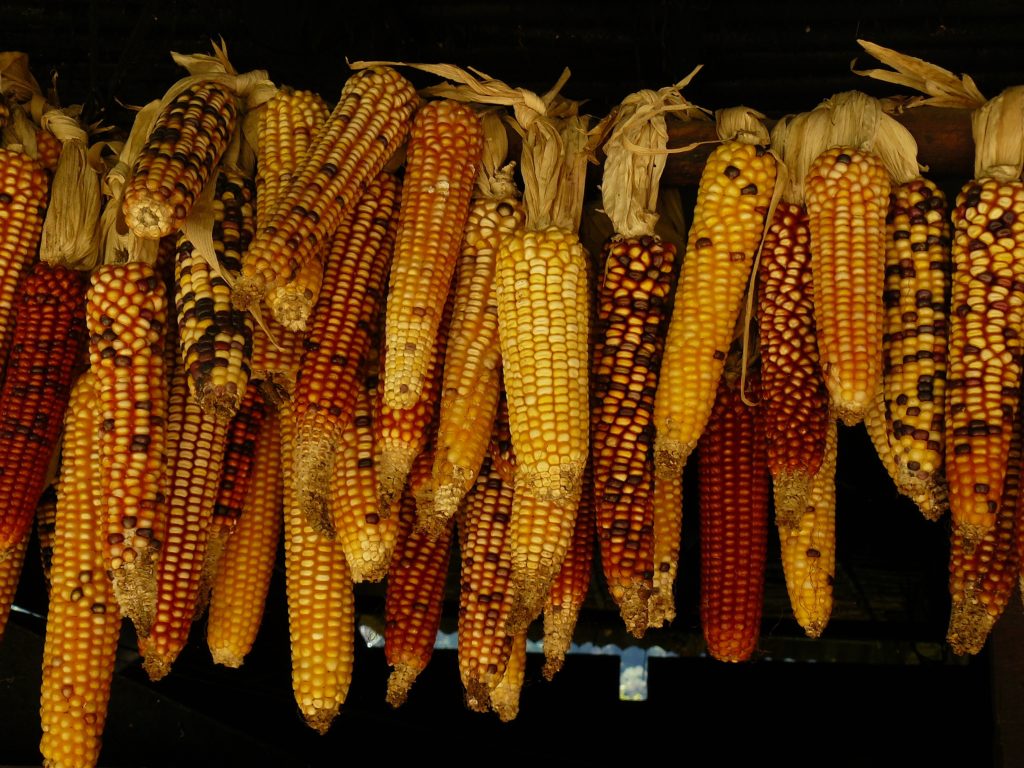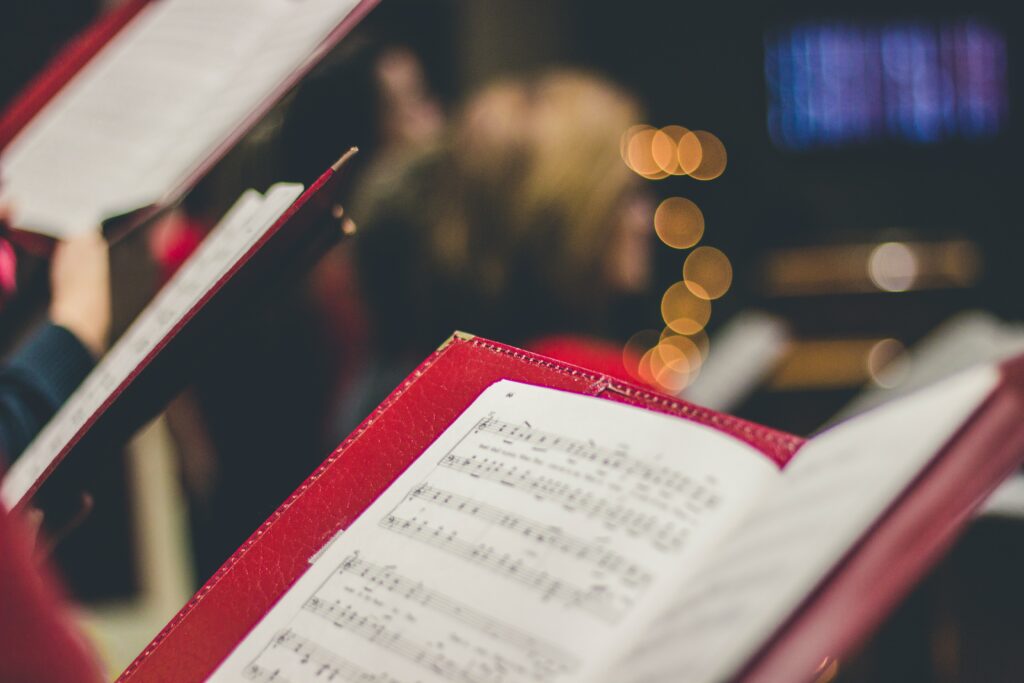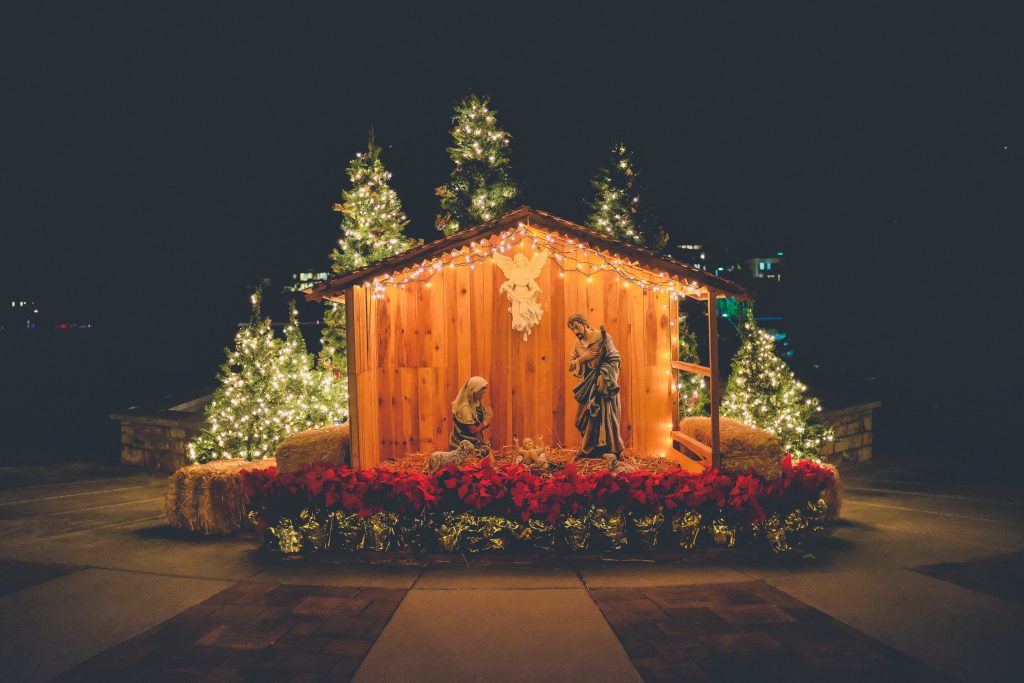
Here’s my annual Thanksgiving post.
Photo credit: Wikimedia
"If the Bible is true, then none of our fears are legitimate, none of our frustrations are permanent, and none of our opposition is significant."

Since my previous post was about the congregational singing part of worship, I’d like to share a little story about another part of worship—the offering.
The first time I took a team of students on a short-term mission trip to Africa, we spent the first 6 weeks in the Kenyan bush, east of Nairobi, in a village called Isovya. We spent a Sunday or two working with a little Presbyterian church there, and on other Sundays various subgroups traveled farther out into the bush (if such a thing were possible) to preach, teach, and provide music in other churches.
The churches were typically mud brick, with a metal or thatched roof, a dirt floor, backless benches, and no glass in the windows. The people would trickle in, and when enough were there, the service would start.
The singing was always energetic; I hold a special place in my heart for the a capella (with maybe a plastic jug as a drum) singing out there in the bush. There is a tonal quality to it that I haven’t found anywhere else in the world.
Then there would be preaching, with an interpreter if called for. One of those Sundays I preached in one of those churches. The congregation was responsive, and the whole service was a delight.
After the preaching they would have the offering. Now, sometimes they would get a few coins, but in many churches there are a good many members who don’t have any money to give. So they bring what they have. Bench by bench, they come forward and place their offering—some fruit, some grain, maybe a pair of sandals crafted from worn-out tires (or tyres, as they would spell it there). This time there were even a couple of live chickens.
Now, as a practical matter, the church can’t really use any of these items, so they do the practical African thing: they hold an auction, and the members who do have some money bid on the items until they’re all auctioned off. That bid money then becomes the offering.
At this service there was a small plastic bag of cowpeas. The bidding commenced, and the bids kept coming. I noticed that an old man, sitting in what American Southerners would call the “Amen Corner,” kept bidding. He really wanted those cowpeas.
He persisted, and he succeeded. The cowpeas were his.
He rose stiffly from his bench, walked slowly to the table, picked up the bag, and then continued walking, up the steps to the platform where I was sitting. And he presented the cowpeas to me.
I was stunned.
My immediate reflex was to decline the offer; he needed the cowpeas far more than I did. But this was an offering, a gift to God, whom that man saw me as representing. The worst thing I could possibly do in that moment would be to reject his gift.
So I bowed slightly, looked him the eye, and told him “Thank you” in Kikamba, the local tribal language.
What a profoundly moving experience.
I later learned that he was an elder in the church. We took the cowpeas back to Isovya and gave them to a Kamba family there in the village.
Worship is a profound thing. God’s people bring what they have, and they offer it to God, who has need of nothing, who is in no way enriched by what they give, but who nonetheless “seeks such to worship him,” according to the Son (Jn 4.23). And that worship, in spirit and in truth, causes the Father to rejoice, and supplies the needs of his people, and gives the givers the opportunity to see God supply their needs and bring them peace.
Different people groups worship in different ways, demonstrating the richness and diversity of God’s creative and providential work, but in every place, in every time, that worship demonstrates God’s goodness in multiple ways.

There’s been a lot of writing—and arguing—about worship, especially over how it ought to be done. I’m not going to rehash the existing hash, which is now solidly stuck to the bottom of the pan. But I did have a thought recently about the specific area of congregational singing.
As a prefatory note, I’ll observe that many these days seem to think “worship” and “congregational singing” are exact synonyms. I would suggest that worship is much broader than congregational singing; I think the whole Sunday gathering is worship—if it’s done with the right attitude—and that in fact our whole regenerate lifetimes should be worship. The word means, after all, ascribing value, “worthship” (what the Hebrews called chabod [“glory”], or “weight”), to God.
But that’s another post. Here I’d like to address just a part of that, the congregational singing.
To begin with, it’s worth noting that if the singing is part of worship, then it is an offering to God. While worship is a joyous thing, bringing delight to those offering it, the worshipers are not the audience; they are the worshipers. As such, they should be focused primarily on bring delight to God; their delight will certainly follow, but it is a side effect, not a goal.
That principle has a good many ramifications, of course. Most obviously, we should offer God what he wants, not necessarily what we want. That’s the thinking behind the Presbyterians’ “regulative principle”—the idea that we should offer in worship only what the Bible specifically commands. Even those who don’t follow the practice should be able to agree that its underlying principle—offering God what he wants—is indisputable.
Of course, the “worship wars” were all about arguing over how we can know what kind of music God likes, and that degenerated into pretty much everybody taking his toys and going home.
But to my point. When we sing as a congregation, we are offering a sacrifice of praise to God. We need to make it the very best offering we can. And I would suggest that we need everybody on board for that to happen. That means that even those who can’t sing well need to contribute. The offering is from everyone.
I’ve never been much of a singer; I was in my high school’s chorale, since I could hit the notes, but I never had any tonal quality. It’s a mystery to me where vibrato comes from, and my abuse of my speaking voice is the stuff of vocal coaches’ nightmares. As I’ve grown older, the tonal quality has stayed flat, the likelihood of my hitting the correct note has decreased, and the breath support is pretty much nonexistent.
So should I just mouth the words and let the singers make the offering?
I don’t think so. (Though if enough of my fellow church members say otherwise, I’ll respect their judgment.) I’m not singing for my own enjoyment, or to impress my fellow pewsitters.
I’m singing to God. He knows what my voice is capable of, and he wants to hear from me.
So I sing.
Anybody who’s been on an athletic team knows what’s going on here. We all—together—do the best we can, and we are brought together by our joint participation.
And God is praised.
Our own enjoyment, as I’ve said, is a side effect, not a goal, but by God’s grace we do reap enjoyment from our team effort. We are delighted as individuals, and we are drawn together as teammates.
Every Sunday, when we gather, we thrive by singing our praise to God—together—and by uniting our hearts in worship. It’s no surprise, then, that one day, in a perfect world, we will gather, from every kingdom, tribe, tongue, and nation, and sing our praise to the Lamb with one voice.
Until then, let us praise him. Together.
Photo by David Beale on Unsplash

I usually write a new post every Christmas, but this year I’d like to direct you to a brief series on the topic that I wrote in 2018.
Merry Christmas!

And then we turn the page, to the New Testament. And in its first words, we meet “Jesus Christ, the Son of David, the Son of Abraham.” And before the end of the first chapter we learn that He is more than that: He is the Son of God as well. God is again stepping into the world he created, this time to fill our cravings.
In the next few pages we learn that Jesus, the Christ, is someone we already know: He is the Son, who in the beginning was face to face with the Father, who made all things, who had tenderly breathed life into His very first image, which He had formed with His own hands. Now these hands touch the sick and heal them; they touch the eyes of the blind and give sight; they touch a few loaves and fish and feed thousands; they touch the dead and bring them back to life. Why should we be surprised? Our first life was from Him, and it is nothing to him to give life again.
All the while His eyes are fixed on His larger purpose in becoming one of us. He sets His face like flint; He goes to Jerusalem; He leaves His hands at His side as evil men slap and strike Him, and then He extends those hands to receive the nails that will pin Him, with the wicked, to a cross long enough for His blood to be shed, so that He can freely deliver His own spirit back to the Father.
It is finished. But it is not over.
The Son, who created the first human life, recalls His own, steps forth from His tomb, with the rich, as victor over both sin and death, and returns to His place beside the Father.
And He continues to speak, through men He has carefully selected while He walked among us. They begin to explain what it all means, and in their writings we learn that, as we have begun to suspect, Jesus, the Christ, is the Prophet, the Priest, and the King, all in one. And He is not disappointing, because He is not broken like Adam’s other descendants. He is the answer to our cravings, cravings that God Himself evoked in us by giving us the Tanakh.
He is our High Priest, perfect mediator of a perfect sacrifice, offered once forever for the sins of all who will come to Him for free forgiveness.
He is our Prophet, the Word become flesh, through Whom we see clearly the Father’s glory, so that if we have seen Him, we have seen the Father.
He is our King, the Son of David, the Lion of the tribe of Judah, the One to whom Judah’s scepter belongs, whose kingdom shall have no end.
He is the Lamb of God, slain from before the foundation of the world. God’s plan has come to fulfillment perfectly, with no missteps, no mistakes, no frustrations, no setbacks.
_____
“Worthy are you, our Lord and God, to receive glory and honor and power, for you created all things, and by your will they existed and were created” (Re 4.11).
“Worthy are you to take the scroll and to open its seals, for you were slain, and by your blood you ransomed people for God from every tribe and language and people and nation, and you have made them a kingdom and priests to our God, and they shall reign on the earth” (Re 5.9-10).
“Worthy is the Lamb who was slain, to receive power and wealth and wisdom and might and honor and glory and blessing!” (Re 5.12).
“To him who sits on the throne and to the Lamb be blessing and honor and glory and might forever and ever!” (Re 5.13b).
“Amen!” (Re 5.14b).
Photo by Greg Rakozy on Unsplash

Once there was nothing.
No time. No now, no then. No was, no will be. No yesterday, no tomorrow.
No space. No length, no width, no height. No up, no down, no left, no right.
No light; but no darkness either.
Nothing.
But there was someone. Or someones, depending on how you count. There were three persons—Father, Son, and Holy Spirit—in perfect harmony and at perfect peace, as One God. They—He—were/was not lonely; they—He—needed nothing.
There was God.
And there was all that God is. There was holiness; there was truth; there was goodness; and there was love.
For His own reasons—which are all the reasons there were—God created the heavens and the earth. And the earth was unformed and unfilled, and covered with a new thing called darkness. And the Spirit, like a mother hen, nestled over the dark surface of the earth, covering, embracing, enfolding.
And then, following the Father’s plan, the Son spoke.
“Let there be light.”
And there was light.
And over the next six days—there were days, and thus time, because there was light—the Son spoke again, and again. And every time He spoke, His words—His commandments—came to pass. The earth, unformed, began to take form. And the earth, unfilled, began to be filled, with life.
And on the sixth day, the Son stopped speaking. He arose from His chair, so to speak, and He stepped into what He had spoken into existence. He knelt in the red clay outside Eden, and with His hands, he began to work.
This time, unlike the other times, He was taking some time. His hands moved skillfully, purposefully, perfectly; and soon there was, lying on the ground in front of Him, the very image of Himself: a body just like the one He had temporarily assumed. Except—it was red, but not yet pink; it was lifeless. Still kneeling, the Son crouched over the lifeless body, placed His mouth on its ashen mouth, and breathed into it.
And man became a living soul. Adam—“Red”—pinked up. The image of God lived.
And then, something even more remarkable happened. The Son—God Himself—spoke to His image. He began to tell him things, about who He was, about what He liked and didn’t like. He offered Adam a chance to know Him. From the very beginning, God wanted to talk to His creature.
Then the Son fashioned a wife for Adam, also in God’s image, but different from Adam in ways that made him better, more complete. And He told her about Himself too. He offered them both Himself.
We all know what happened next. After Eve was deceived, Adam knowingly rejected God’s offer of fellowship and plunged all that God had made into chaos and death. And though God expelled them from the Garden, He kept talking to them and to their descendants.
He spoke in an audible voice. He spoke in dreams and visions. He spoke through dew on a fleece, and through a bush that burned but wouldn’t burn up. Once he even spoke through a donkey.
And along the way, even though He was communicating already in all these ways, He went even further. He began to see that the things He spoke were written down, so that more people could read His words than heard Him speak them.
And the story He told had a single theme, in three parts. In the first part, called the Torah, God gave His people priests and sacrifices to wash away their sin and bring them back into fellowship with Him. But the sacrifices had to be made every day, twice a day. And there were other sacrifices: sin offerings, guilt offerings, trespass offerings, peace offerings, heave offerings, wave offerings. Why wasn’t there a priest who could offer a complete sacrifice—who could get the job done, and wash away our sins once forever?
In the second part, called the Prophets, God spoke to His people through special spokesmen. There were many of them, and they spoke faithfully. But they, too, had a problem: sometimes they couldn’t understand their own messages, and sometimes they couldn’t describe what they saw in words that made sense to us. They spoke of wheels within wheels, and of a man who made his grave with both the wicked and the rich; they spoke of little horns and abominations of desolation, and it was often deeply confusing. Why wasn’t there a prophet who could speak clearly—who could tell us, in words we could understand, what God is like, and what He wants from us?
In the third part, called the Writings, God gave His people kings to fight their battles for them. The first king was tall and handsome, and everyone liked him. But he was a real disappointment. So God picked a king for them, a young man with a soldier’s skill and courage and a musician’s tender heart. And for much of his reign he was joyously good; but in the end he fell into sin and descended his family into the same kinds of chaos that Adam had brought on us all from the beginning. The next king, his son Solomon, began well, but by the end of his life he was worshipping idols even after he had built a magnificent temple for the true God. And then the kingdom split, and while a few kings glimmered with hope and light, most of them just descended deeper and deeper into darkness. Why wasn’t there a king who could rule us well—who wouldn’t disappoint us?
And so God’s Word to Israel, the Tanakh, ends, leaving us craving what we need from God, but unsatisfied. We need a priest. We need a prophet. We need a king. Even just one of them would be a blessing.
The story continues next time.
Part 2: Utter Satisfaction, Utter Joy
Photo by Greg Rakozy on Unsplash

We live in unstable and unhappy times. Lots of people are complaining—and there’s a lot to complain about. But we all know that living in a spirit of complaint isn’t good for us, and we also know that we tend to magnify our difficulties and minimize our joys.
I’ve been spending extra time in the Psalms lately, and I’ve found that time to be well invested. It’s good to be around happy people—though not all the Psalms are happy, certainly—and it’s good to be reminded that our time is not substantially different from what lots of other people have endured, and over which they have triumphed.
Psalm 103 is a simple meditation on good things, encouraging things—and better yet, eternal things. According to its superscription, it’s Davidic—by David, or perhaps for him or in his style; the Hebrew preposition can mean a lot of things. It begins and ends with a call to praise, first by the author himself (Ps 103.1-2) and at the last by all of creation (Ps 103.20-22). In between, the Psalmist considers some of the reasons why we should praise God—and along the way there’s a hint that his life hasn’t been all sunshine and roses.
We’ve all heard the children’s prayer at mealtime:
God is great,
God is good;
Let us thank him
For our food.
This psalm appears to pray that prayer on a much grander scale.
The Psalmist begins—after the initial call to praise—with God’s goodness (“his benefits,” Ps 103.2), and specifically his goodness to the Psalmist himself as an individual. He lists those benefits in two categories.
First, God has delivered him (and you, and me) from many of the negative things about life:
Then the Psalmist considers how he has replaced those negative things with positive ones:
There’s a lot more that God does for each of us that demonstrates his goodness; the Psalmist has given us just a sampling. We can profitably meditate on the much longer list. And as we’ll see, the Psalmist is just getting started.
Next time.

This Christmas season I’d like to engage in a thought experiment by telling a story that I’m pretty sure never happened.
__________
An angel walks into the Executive Office Wing of heaven and steps up to the receptionist.
“I’d like to see the Son, please.”
The receptionist replies, “I’m sorry, but you can’t see the Son right now.”
Now, this is the first time those words have ever been uttered. The angel is taken aback.
“I can’t?! Why not?!”
“Well, he’s not in.”
“He’s not in?! What do you mean, ‘He’s not in’?! He’s omnipresent; how can he be ‘not in’?!”
“Well, he’s not here.”
The angel sputters.
“OK, you’re not making any sense, but I’ll play your little game. ‘Where’ is he? If you’ll tell me ‘where’ he is, I’ll go ‘there’ and talk to him.”
“Well, I could tell you where he is, but even if you go there, you won’t be able to talk to him.”
“Why not?”
“Well …”
The receptionist pauses for an awkwardly long time.
“Um, he can’t talk.”
The angel is apoplectic.
“He can’t talk?! What kind of nonsense is this?!”
“Well, … he’s a fetus.”
__________
There are several reasons that I’m fairly sure this scene never happened.
For one thing, while I suppose it’s possible that the executive offices of heaven have a receptionist, there don’t seem to be any of the usual reasons why one would be needed, and there’s no biblical indication of such a position.
Second, my story has a logical problem. Why is the angel bamboozled by the concept of “going there” to talk to the Son, if he’s come to the Executive Office Wing to talk to him?
For another, I’m quite doubtful that any unfallen angel was surprised by the incarnation. This event had been predicted in the Garden of Eden—possibly by the Son himself—and angels seem to be the kinds of persons who pay attention.
So it almost certainly never happened.
But it illustrates a few of the complexities that we celebrate at this time of year—complexities that we often gloss over because we’re just so familiar with the whole concept that God became man.
What an incomprehensible thing.
What happened when a member of the Godhead became germinal (pre-embryonic)? Did he, unlike other germinals, know what was happening? If his knowledge was limited in some ways during his season on earth (Mk 13.32), how extensive was that limitation, and did it change over time? If he is fully human, did he have to grow a brain during his embryonic stage? And if so, did he have any human consciousness before his brain developed?
The Bible tells us that the Son is the agent of providence; by him all things hold together (Col 1.17). Was he maintaining the universe and directing the affairs of people and nations while he was a fetus? Or is there some sort of 25th Amendment in heaven, whereby the Son hands over those responsibilities to the Father or the Spirit while he’s temporarily intellectually incapacitated?
We have no idea what we’re talking about.
He learned, right? How did that work?
Did the 12-month-old Jesus walk the first time he tried, or did he “fall down and go boom” while learning? Did Joseph ever say to him, “Now, Son, if you hold the hammer that way, one of these days you’re going to hurt yourself”? Did Mary ever say the Aramaic equivalent of “No, Jesus, it’s not ‘Can me and Simeon go out and play,’ but ‘Can Simeon and I go out and play’ “?
The Bible doesn’t speak to these things. It does tell us that he developed “in wisdom and stature, and in favor with God and man” (Lk 2.52). How did he grow in favor with God?!
I’ve studied the Son at a serious level for five decades. And the more I think and read, the more convinced I am that there is more to this person than we will ever know. And there is more to the Incarnation—to Christmas—than we can possibly conceive.
At some point, we simply have to thank the Almighty.
And worship.
